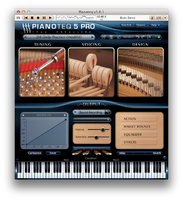

- Pianoteq 5 kickass pro#
- Pianoteq 5 kickass Bluetooth#
- Pianoteq 5 kickass mac#
- Pianoteq 5 kickass windows#
Pianoteq 5 kickass mac#
The current crop of mac MINI"s would be stupid fast but watch the cost ballon on the current models once you start to pay Apple for their ram and bigger internal SSD. My 20212 i7 quad core is still very fast for running MainStage and BIG concert setups with things Like Ivory, Keyscape, Arturia V collection etc.
Pianoteq 5 kickass Bluetooth#
Driving the mac with a touch screen is not always ideal so sometimes I carry a bluetooth keyboard and mouse to make that easier during rehearsals when I"m still modifying things. I use an old iPad for my screen (the few times I need it) with 2 different apps - a VNC app called Screens and another called Duet Display. I don"t think you can fit more SSD"s inside the current crop but the new SSD"s are so small now that an external one hanging off one of the USB C ports is not inconvenient. The Mac MINI is the last 2012 machine Quad Core i7 with 2 SSD"s inside. Over almost a decade, Pianoteq has gone from strength to strength.Elmer J, this is exactly what I have been doing for quite a few years. Version 5 offers astonishing realism with remarkably low CPU and hard-drive requirements.ĭoesn’t time fly? Not so long ago the idea of a computer model of a musical instrument that you could actually play would have seemed like science fiction. And yet, it’s already been nearly a decade since French developers Modartt first released their modelled piano software, Pianoteq. In that time they’ve subjected it to continuous development, refining the basic acoustic model, and releasing new pianos and other instruments to run within it. So with this latest version 5 Pianoteq is more capable and flexible than ever, and that’s been matched by some important changes in the way it’s sold, as we’ll see. Pianoteq runs in OS X, Windows, and Linux.
Pianoteq 5 kickass windows#
You’ll need OS 10.5 or later, Windows XP, Vista, 7 or 8, or Linux (x86) with Jack and ALSA back ends. There are 32– and 64–bit variants, and as well a stand–alone version it’s provided in VST, RTAS and AAX plug–in formats for OS X/Windows, as well as in Audio Units for OS X.įully equipped, Pianoteq offers an embarrassment of riches pianos, electric pianos, and many different mallet percussion sounds. After you’ve chosen your basic sound ‘flavour’ at purchase, additional instruments are available for €49/$89 a pop.Then, regardless of your chosen platform, the installation size is almost incomprehensibly, laughably tiny - at least compared to any half–decent sampled piano competition. It occupies a mere 40MB or so on your hard drive, which to put it in perspective is over 3000 times smaller than Garritan’s CFX Concert Grand. Pianoteq doesn’t require much memory either - 256MB is sufficient. That makes it very suitable for users of laptops with solid-state drives, for example, which may not have a great deal of storage capacity. Theres a surroundcapable multichannel virtual miking. A modest multi–core chip like Intel’s Core i3 is recommended as the minimum spec for the CPU. Still very capable, Standard forgoes only the high sample-rate support and pernote sculpting of Pro. Pianoteq 5 continues on with a very similar look and feel as its previous versions. The exact layout depends on which version of Pianoteq you’ve stumped for, of which there are three: The compact user interface (roughly 600 x 600 pixels, though scalable between 50 and 250 percent of that size) arranges panels for tweaking various aspects of the sound and playback characteristics beneath a preset management section, and above a representation of a piano keyboard and pedals.

This most expensive variant offers the full, unrestricted Pianoteq experience.

There’s huge scope for sound design, even on a note–by–note basis (which pretty much lets you do ‘prepared’ piano setups, à la John Cage). There’s a surround–capable multi–channel virtual miking scheme, you can load your own impulse responses into the onboard convolution reverb, and supported sample rates stretch to 192kHz. Still very capable, Standard forgoes only the high sample-rate support and per–note sculpting of Pro.
Pianoteq 5 kickass pro#
Interestingly, though, it’ll actually load Pro presets, with per–note adjustments intact - you just won’t be able to alter them yourself.


 0 kommentar(er)
0 kommentar(er)
